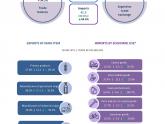In the first six months of the year, exports reached the highest level for this period, exceeding the previous record of January-June 2011. In turn, imports made up the highest historical value for a first semester.
Highlights:
▪ In the first half of the year, exports totalled US$ 44.4 billion, which represents a record level for that period, exceeding by 12% the maximum previous value of January-June 2011. They accumulate a y-o-y increase of 25.5%, which is explained by a rise in prices (22.5%) and, to a lesser extent, in quantities (2.4%).
▪ Imports totalled US$ 41.3 billion in January-June (a 44.4% increase), which makes up the highest historical value for a first semester. They were driven by higher quantities and prices –at all-time highs– of Fuels and lubricants, and by increases in the prices of Intermediate goods and in the quantities of Capital goods and their parts.
▪ The trade balance achieved a surplus of US$ 3.1 billion, US$ 3.7 billion less than the positive result of January-June 2021, resulting from the greater pace of growth of imports (44.4%) than exports (25.5%).

▪ The three main partners, Brazil, China and the United States, absorbed as a whole 27.2% of the exports and supplied 52.9% of the imports in January-June 2022.
▪ The largest surpluses were in trade with Chile (US$ 2.2 billion), India (US$ 1.8 billion), the Netherlands (US$ 1.6 billion), Peru (US$ 1.1 billion) Indonesia (US$ 1.1 billion) and Algeria (US$ 910 million).
▪ The highest deficits were recorded with China (US$ 5.8 billion), Brazil (US$ 2.1 billion), the United States (US$ 1.8 billion), Germany (US$ 988 million) and Thailand (US$ 730 million).
▪ Highlights include increases in wheat exports (US$ 1.9 billion), crude oil (US$ 1.2 billion), maize (US$ 1.0 billion) and biodiesel (US$ 682 million). The biggest falls correspond to the soybean complex: beans (−US$ 639 million) and flour and pellets (−US$ 130 million).
▪ It is worth highlighting the increases in the prices of all the products of the soybean complex: oil, 44.1%; biodiesel, 34.1%; beans, 22.1%; and flour, 7.3%. In relation to the quantities, those of biodiesel (54.1%) increased, while those of beans (−72.3%), oil (−27.9%) and flours and pellets (−9.0%) decreased.
▪ Regarding imports, there stand out the highest purchases of diesel oil (US$ 1.9 billion), liquefied natural gas (US$ 1.0 billion), gasoline, excluding that for aviation, (US$ 373 million), and fuel oil (US$ 365 million), while those of soybeans (−US$ 189 million) decreased.





